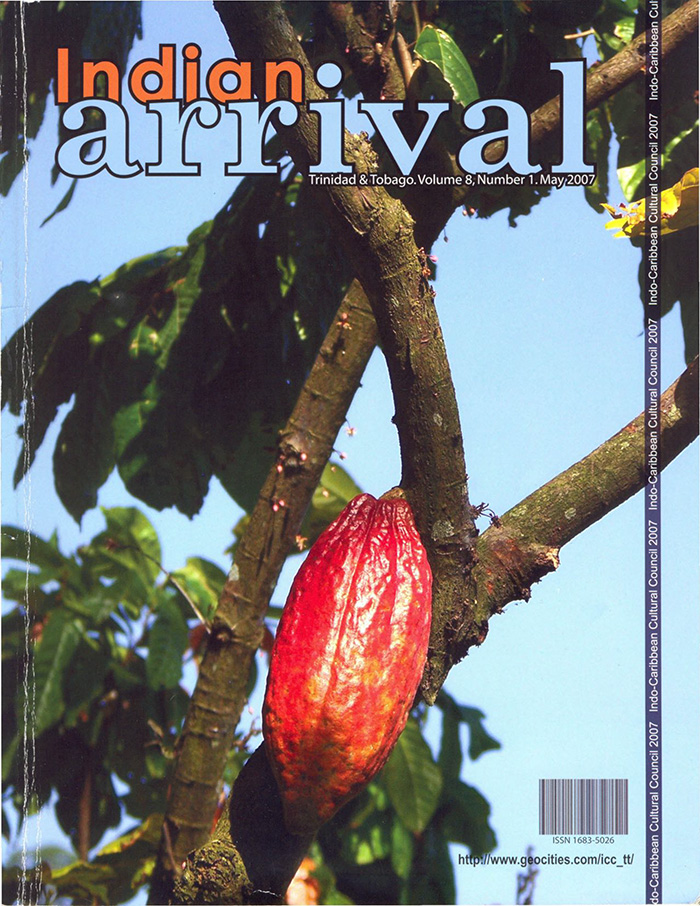
Indian Arrival Day commemorative magazine 2007
It is not well known today that South Asian/East Indian immigrants were indentured on estates other than sugarcane plantations. When the price of sugar in the world market fell in the mid-1880s, cocoa, coconut and rubber became alternative crops cultivated for export. Cocoa surpassed sugar as the most valuable export crop in Trinidad during, and just after Indentureship, and Indians were at the forefront of this agricultural enterprise. Indians worked in cocoa estates in Diego Martin, Lopinot, Sangre Grande, Grand Couva, Oropouche, Siparia, Fyzabad and Avocat. In 1920, cocoa beans made up about 43 percent of the British colony’s total export.
From World War 1 (1914-1918) until 1921, copra [from coconut] prices rose rapidly and production doubled with the additional labour of Indians. They worked on coconut estates in Cocal and Ortoire along the Manzanilla-Mayaro Road, and Cedros and Icacos in the south-west peninsula of the island. A few hundred Indians were also indentured on rubber estates in Trinidad, and perhaps Guyana. As early as 1910, about 3000 acres of land were grown with Castilloa rubber mainly in Rio Claro. Later, the Para [Hevea Brasiliensis] variety was cultivated in Talparo, Ecclesville, Phoenix, Guayabe, Vessigny, Biche, Matura and Sangre Grande.
Read Online
May-June 2007
11 x 8 ½ inches
80 pages with advertisements and articles
ISSN 1683-4143
Glossy pages and cover
TABLE OF CONTENTS
- Indian indentureship on Cocoa, Rubber and Coconut Plantations: Editorial Dr Kumar Mahabir
- Greetings from the High Commissioner of India: His Excellency Jagit Singh Sapra
- Greetings from the High Commissioner of Britain: His Excellency Eric Jenkinson
- Indians absconded to work in cocoa plantations: Cocoa and Indian Indentured labourer
- Indians were the pioneers in this agricultural enterprise: Cocoa and Indian Indentured labourer
- The rate of squatting on Crown lands was increasing: Cocoa and Indian Indentured labourer
- Indians from the first immigrant ship were indentured in Lopinot: Cocoa and Indian Indentured labourer
- During indentureship some free Indians owned substantial cocoa holdings: Cocoa and Indian Indentured labourer
- Some free Indians signed a contract with large landowners: Cocoa and Indian Indentured labourer
- Cocoa farming grew to rival sugar cultivation in importance in the 1890s: Cocoa and Indian Indentured labourer
- Most small holders lived under their cocoa drying house: Cocoa and Indian Indentured labourer
- Indians established new, or bought existing cocoa estates: Cocoa and Indian Indentured labourer
- The fermentation process in the “sweat box” melts the pulp: Cocoa and Indian Indentured labourer
- Immigrants worked on coconut estates along the Manzanilla-Mayaro road and Coromandel and Icacos: Coconut and Indian Indentured labourer
- People used the beach in Manzanilla at low tide as a pathway: Coconut and Indian Indentured labourer
- Labourers also planted coconuts in nurseries on the estates: Coconut and Indian Indentured labourer
- Indians climbed, picked, collected and transported coconuts in carts: Coconut and Indian Indentured labourer
- Coconuts were chopped open for their thick dried kernel (copra): Coconut and Indian Indentured labourer
- Some poor Indian workers still live in barrack-type wooden cottages: Coconut and Indian Indentured labourer
- Nazir Mohammed, 93, recounted his journey from India: Coconut and Indian Indentured labourer
- Cows, bulls, bison and goats were not raised on coconut estates: Coconut and Indian Indentured labourer
- In 1891 in Los Gallos three American ships were loading coconuts: Coconut and Indian Indentured labourer
- In 1910, about 3000 acres of land were cultivated with Castilloa rubber mainly in Rio Claro: Coconut and Indian Indentured labourer
- Each tapper on Non Pareil estate was assigned two fields consisting of about 300 to 400 trees each: Rubber and Indian Indentured labourer
- Trinidad rubber is considered to be of the best quality in the world: Rubber and Indian Indentured labourer
- Seeds were originally imported from Brazil, through England, for propagation: Rubber and Indian Indentured labourer
- Indentured labourers lightly covered the seeds with soil: Rubber and Indian Indentured labourer
- The indentured worker carved incisions on the trunk of the rubber tree: Rubber and Indian Indentured labourer
- Indentured Indians were required to be in the fields before day-break: Rubber and Indian Indentured labourer
- Rubber plantations grew to be the ideal habitat for bees: Rubber and Indian Indentured labourer
- Poultry was reared by a few Indian workers living near Non Pariel rubber estate: Rubber and Indian Indentured labourer

is a full-time anthropologist at the University of Guyana (UG) and Fellow of The Eccles Centre for American Studies, British Library (2022-23). He is a former Assistant Professor at the University of Trinidad and Tobago (UTT). He obtained his Ph.D. in Anthropology from the University of Florida (UF). As a doctoral student, he won a Florida Caribbean Institute Award, an A. Curtis Wilgus Grant, and an Organization of American States (OAS) Fellowship.
Mahabir received a National Award (Hummingbird Silver Medal) for his contribution to education in his country in 2011. He was among 50 recipients who received a Distinguished Alumni Award from the UWI Alumni Association.
Mahabir is the author of 12 books to date.
